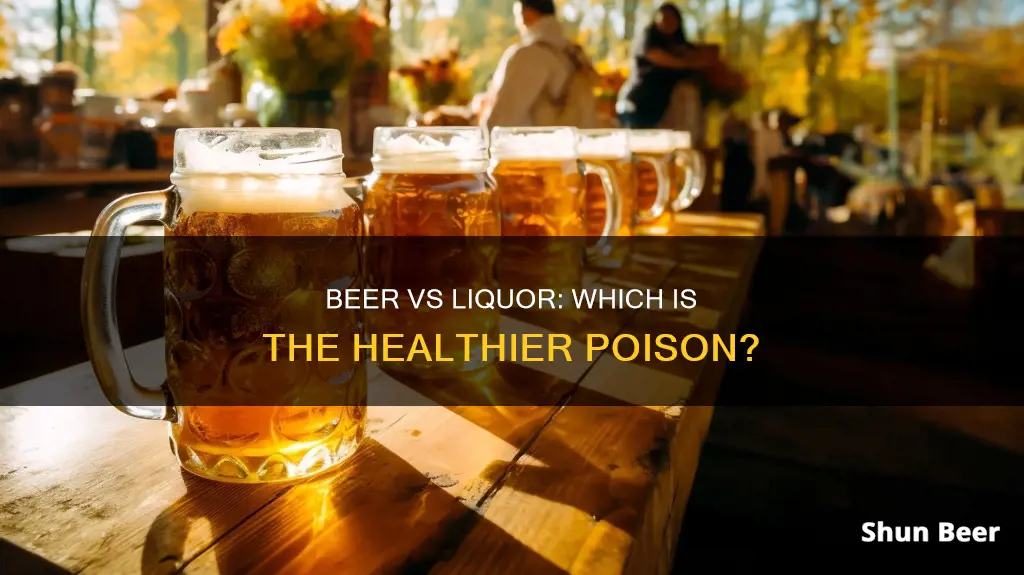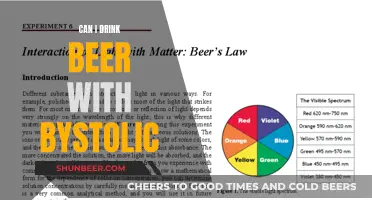
Alcohol, in moderation, can have health benefits, but excessive consumption can be detrimental to health. Beer and liquor have different production processes and ingredients, but both contain ethanol, which is responsible for most of the health benefits associated with alcoholic drinks. Beer has more antioxidants than liquor, but liquor often has fewer or no carbohydrates. The higher alcohol content in liquor means that it can have stronger effects and be more dangerous than beer. However, the choice between beer and liquor depends on individual preferences, as both have similar risks when consumed in excess.
What You'll Learn

Beer has more antioxidants than liquor
The antioxidants in beer are flavonoids, which are characterised by the presence of one or several phenolic groups. These phenolic groups can reduce reactive oxygen species and various organic substrates and minerals. This is why beer is associated with a reduced risk of cardiovascular disease.
The phenolic compounds in beer are also known as polyphenols, which have anti-inflammatory, antioxidant, and hypocholesterolemic properties. Polyphenols prevent the oxidation of low-density lipoproteins by blocking free radicals that can oxidise fats in the body. Polyphenols are also recognised as preventers of colon cancer and can cause positive changes in gut microbiota.
The type of beer affects its antioxidant content. For example, dark beers have a higher antioxidant activity than lager beers. This is because dark beers are brewed from malt that is more toasted than in lager beers. The roasting of malt increases the content of xanthohumol, which is one of the most important antioxidants in beer.
Beer and Straws: A Refreshing Combination?
You may want to see also

Liquors are served as cocktails and blended with non-alcoholic mixers
Liquors are distilled spirits with a higher alcohol content than beer, and they are often served as cocktails blended with non-alcoholic mixers. This practice of mixing liquors with non-alcoholic beverages has several implications for drinkers. Firstly, the non-alcoholic mixers can mask the strong flavour of the liquor, making it easier to consume larger quantities without realising. This is especially true when liquors are served in shot form, as people tend to down them quickly. Additionally, the mixers can add more calories and carbohydrates to the drink.
Cocktails are generally made up of three or more liquid ingredients, with at least one being alcoholic. For example, a spirit and mixer, such as gin and tonic, is a simple combination, whereas a cocktail like a Bloody Mary blends vodka and tomato juice with additional ingredients like lemon juice, hot sauce, Worcestershire sauce, horseradish, fresh herbs, brown sugar, and cracked black pepper. Another example is the Aviation cocktail, which combines gin, maraschino liqueur, creme de violette, and lemon juice.
Liquors can also be blended with non-alcoholic mixers to create unique flavour profiles. For instance, the popular cocktail, Dark and Stormy, starts with dark rum and is then mixed with ginger beer and lime juice. Similarly, a Moscow mule is made with vodka, ginger beer, and lime juice. These cocktails showcase how liquors can be blended with non-alcoholic mixers to create a variety of flavour profiles, from spicy and savoury to sweet and fruity.
When drinking cocktails, it is important to be aware of the added ingredients and their potential effects. While the non-alcoholic mixers can enhance the flavour and make the cocktail more enjoyable, they can also increase the calorie and carbohydrate content. Additionally, the masking effect of the mixers can lead to overconsumption, especially with shots of liquor. Thus, it is crucial to track alcohol consumption and be mindful of the potential risks associated with drinking spirits.
The Science Behind Foam Beer Koozies: Do They Work?
You may want to see also

Beer is safer to drink than liquor in places where water is unsafe
It is a common misconception that people in the Middle Ages drank beer instead of water due to poor water quality. While it is true that Medieval water sources were often polluted and full of bacteria, people still drank water, and clean water was accessible in many places. Medieval towns and cities were usually established near a source of clean water, such as rivers, and local leaders made efforts to provide their people with access to it.
However, beer was indeed consumed in large quantities during this period. Beer was considered a nutritious supplement, as the boiling of the mash during brewing killed harmful bacteria in the water, and the mash gained nutrients from the barley and other ingredients. Beer was also used to pay taxes and tithes, and it was a popular drink during celebrations and feasts.
In places where water quality is poor, beer can be seen as a safer alternative, as the brewing process kills bacteria and makes the water safer to consume. However, it is important to note that both beer and liquor contain ethanol, a recreational drug, and excessive consumption of either can lead to detrimental health effects.
Liquor, also known as distilled spirits, is made by refining grains, vegetables, and fruits, resulting in a higher alcohol content than beer. This higher alcohol concentration can make liquor more dangerous, as it can lead to quicker intoxication and mask the taste of alcohol, potentially leading to overconsumption.
In summary, while beer may be safer to drink than liquor in places with unsafe water sources due to its ability to kill bacteria during the brewing process, it is important to consume any alcoholic beverage in moderation to avoid negative health consequences.
Apple Cider Vinegar and Beer: A Healthy Mix?
You may want to see also

Liquors have a higher alcohol content than beer
Because of its higher alcohol content, liquor can produce stronger effects than beer. A shot of liquor can be more intoxicating than a can of beer, and it takes much less liquor to cause the same effects as a mug of beer or a glass of wine. This means liquor can hit people harder and faster.
Liquor is also often served as cocktails, blended with non-alcoholic mixers and ingredients to create a unique flavor. This can be dangerous because the strong flavor of liquor can be masked, making it easier to consume more than intended. Additionally, liquor is often consumed in shots, which can be downed in a matter of minutes, leading to quicker intoxication.
The higher alcohol content in liquor also means that it can be easier to over-pour and lose track of how much you are consuming. As a result, liquor poses a higher risk of overindulgence and binge drinking, which can lead to growing alcohol dependence and potential addiction. Therefore, it is important to be aware of the ABV of the beverage you are consuming and to track your consumption accordingly.
Understanding Beer Flash Coolers: Science Behind the Froth
You may want to see also

Beer has nutritional benefits, such as B vitamins and soluble fibre
Beer has been consumed for thousands of years and is one of the most popular alcoholic beverages worldwide. It is made from brewing and fermenting cereal grains with yeast, hops, and other flavouring agents. While beer is often viewed as empty calories, it does contain some nutrients.
Beer is made from cereal grains and yeast, which are a source of B vitamins. Beer also contains soluble fibre, which is composed mainly of indigestible carbohydrates. The specific type of soluble fibre found in beer is called dietary fibre (DF). DF in beer is highly fermented by colonic bacteria, similarly to healthy soluble fibres like psyllium and β-glucans. The consumption of 150 ml of beer per day in Spain accounts for 1.6% and 5% of the total DF and soluble DF intake of the diet, respectively.
In addition to soluble fibre and B vitamins, beer also contains small amounts of potassium, calcium, thiamine, iron, and zinc. Beer is also a source of antioxidants, with a majority coming from the malt and the remainder from the hops.
However, it is important to note that the amount of these nutrients in beer is relatively small compared to whole foods like fruits and vegetables. You would need to drink large amounts of beer to meet your daily nutrient requirements. Therefore, while beer does have some nutritional benefits, it should not be relied upon as a significant source of these nutrients.
Viagra and Beer: A Safe Combination?
You may want to see also
Frequently asked questions
Beer has more antioxidants than hard liquor, but their overall effect is small. Beer is also lower in calories, lower in carbohydrates, and has no fat or cholesterol. However, liquor often has fewer or no carbohydrates and is less likely to be consumed in excess due to its stronger flavour.
Alcohol is toxic to the liver, and prolonged alcohol abuse, regardless of the type of drink, can damage this organ. However, liquor has a higher alcohol content than beer, so it can cause more harm in a shorter amount of time.
Liquor is often served as cocktails, which can mask the taste of alcohol and cause people to consume more than they intended. Liquor is also more likely to be consumed in shots, which can lead to multiple servings being consumed in a short amount of time.







